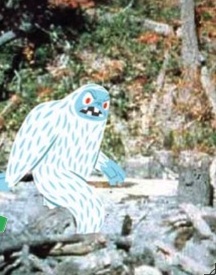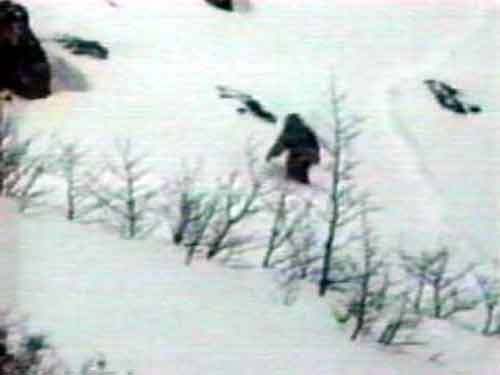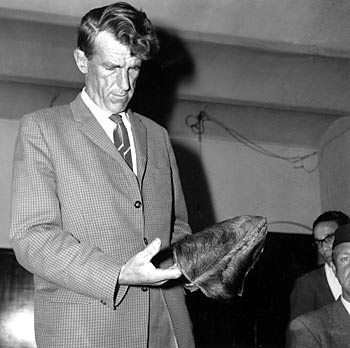Why Are There No Great Yeti Photos?
Posted by: Loren Coleman on August 14th, 2010
I bemoan the fact that despite hundreds of years of eyewitness sightings, and hundreds of miles of trackways of footprints, there are no really sterling photographs of Yetis (a/k/a Abominable Snowmen). Or good videos.


The absolutely clear ones have turned out to be fakes.

Or mistakes.

Or ritualistic takes.
One of life’s enduring mysteries, I suppose.

About Loren Coleman
Loren Coleman is one of the world’s leading cryptozoologists, some say “the” leading living cryptozoologist. Certainly, he is acknowledged as the current living American researcher and writer who has most popularized cryptozoology in the late 20th and early 21st centuries.
Starting his fieldwork and investigations in 1960, after traveling and trekking extensively in pursuit of cryptozoological mysteries, Coleman began writing to share his experiences in 1969. An honorary member of Ivan T. Sanderson’s Society for the Investigation of the Unexplained in the 1970s, Coleman has been bestowed with similar honorary memberships of the North Idaho College Cryptozoology Club in 1983, and in subsequent years, that of the British Columbia Scientific Cryptozoology Club, CryptoSafari International, and other international organizations. He was also a Life Member and Benefactor of the International Society of Cryptozoology (now-defunct).
Loren Coleman’s daily blog, as a member of the Cryptomundo Team, served as an ongoing avenue of communication for the ever-growing body of cryptozoo news from 2005 through 2013. He returned as an infrequent contributor beginning Halloween week of 2015.
Coleman is the founder in 2003, and current director of the International Cryptozoology Museum in Portland, Maine.










No good video’s? Youv’e got to be joking Loren. The P/G footage has passed the test of time despite every attempt to debunk it. While personally not accepting footage and story as Gospel ,one can hardly say it’s not a good video.
However the fact so little photographic / video evidence has come to light in our modern age and while not wishing to destroy youngsters dreams of the ‘Tooth Fairy’ the chance of an 7-8ft tall ape living in North America is somewhat slim.
The Patterson-Gimlin footage is of an unknown North American hairy hominoid, called Bigfoot, Sasquatch, and Oh-Mah. whereas this posting is about Abominable Snowmen, Yetis, Meh-Tehs.
These are the cryptids from Asia (e.g. Nepal, Mustang, Bhutan, perhaps Tibet), not Canada and the USA.
They are apples and oranges.
MY thoughts are of Yetis.
Why is there not ONE SINGLE good photo of BF? BF should be easier to capture “on tape” than the Yeti, not? Since it’s in NA and Canada and the Yeti is hiding in mountains of Tibet etc. I can understand why we have little on Yeti, but BF is has little more excuses… I still make the best images with my cellphone sometimes. I can send you some pictures sometime, Loren. Not just to prove a point, but for you to see how nice this country can be 🙂
Loren, that is a very good question! I think there are probably several reasons for there not being “sterling” photographs of yetis.
I believe the problem areas are geography and climate, the nature of the beast when dealing with mechanical equipment, and limited experience of the photographer trying to capture an image.
When we take a look at probable yeti geography, it is demanding. Think about the altitude, terrain, temperature, remoteness of the location, and lighting conditions. Altitude can come into play. The thinner air puts demands on the body of the photographer. Altitude sickness can come into play. And even if the photographer does not become sick per se, the cognitive abilities of the photographer would be affected. The photographer could spot a subject and have to “think” what lens and settings to use instead of “reacting”. That delay could effect the end results as far as photography is concerned. Also, altitude sickness could play tricks on the mind of the photographer. Soon, rock outcroppings, trees, and other animals start to look like yetis at a distance. They take a photograph and later find out that they have a clear photograph of rocks.
What if the photographer could react in time with the altitude not effecting his thought process dramatically. Well, sometimes, the camera has limitations! If the subject is in a shaded area, no matter how high of an ISO your camera has, it may not be enough for the lens and light conditions. The end result if the yeti is moving, is a blurry photograph. Night photography is pretty much out of the question as well. So the photographer would be limited to day time shots. When are yetis supposedly most active? So this limits opportunity for getting a clear photograph.
We also know it can get cold in yeti territory. This plays havoc with camera equipment. Batteries are effected directly. Where can you recharge a battery to keep them at full power in a cold and desolate place such as yeti territory? This creates a major stumbling block. I know when I do cold weather photography, I try to keep the spare batteries and camera close to me body so that they maintain the power when I need it. But even in subfreezing temperatures, taking all precautions, the batteries tend to fail after a couple of hours.
The second problem in obtaining sterling yeti photographs is mechanical problems. I already discussed battery issues but other mechanical problems can arise in cold weather conditions. In cold weather conditions, the aperature on your lens could stick and remain stuck. This limits what photographs you can take with acceptable results. Also, if there is rain or snow, you continually have to clear your lens and we all know moisture and camera equipment do not mix! The slightest amount of moisture can lead to disasterous results. Having back up cameras is a must but they are subject to the same conditions. Photographers do not know they have an equipment problem until they try to take a photo. So after checking their cameras and equipment and giving them a passing grade, they set off in hopes of getting a yeti photograph. They eventually see a yeti. It is their opportunity to react. They go for the camera and now realize there is some type of mechanical problem. As they try to ascertain what the problem is as quickly as possible, the yeti slips away. There were 10 seconds of opportunity to get several good shots but that opportunity was foiled by mechanical difficulties that could not be foreseen. The nature of the beast of the mechanics of photography killed the opportunity to capture a real beast on film, or digital media!
Last but not least, is the ability or experience of the photographer. Many times, there are great cryptozoologists trying to find the yetis. However, being a good cryptozoologist does not equate to being a good photographer. Even if you are able to find a yeti, lack of photographic experience wipes out any opportunity of getting a sterling photo. It would be a challenging task even for an experienced professional photographer, to get an acceptable shot given the terrain, climate, and lighting conditions.
It is no wonder to me, that there are not any sterling photographs of yetis out in cyberspace! I expect that to be the case. I also think that we have to take into account the experience and emotions of seeing a yeti or BF in North America for that matter. I imagine we can not discount the emotions and feelings the observer would have to deal with. That probably translates into photos not being taken as the observer is in shock and awe mode.
Hopefully my insight has shed some light on this matter, as to the reasons why there might not be any sterling photographs of yetis.
My guesses:
1) Lack of cameras. Until recently, I suspect these were pretty hard to come by in the area.
2) Camoflage. It can’t be easy picking out a yeti against a snow bank.
3) Have you ever tried to use a camera while wearing mittens? I can’t even make cell phone call!
There’s a simple reason, right there in front of you: they don’t exist.
Quite so Loren. As often as not, I’ve completely misread your posting.
The remoteness of the Yeti habitat and lack of local technology is sufficient for lack of evidence.
Some good technical points have been made here about expertise and equipment, and, from my experience, they are all valid. I would add that much of the technology that we have today in the West, is still new and or exorbitantly expensive to Tribal peoples. For example, when I used a flash in the Congo, some of the older people ducked, thinking it was a lightning bolt!
I have had several cameras fail on me due to humidity, as one commentator suggests. Last year, in Sumatra, I also had the Orang-Pendek try to evade me and the rest of the team by pinning itself against a tree. Ultimately, they are very rare, very resourceful creatures in often extreme conditions. The other important point I would add, is that in some areas, such as Nepal, I think we are seeing a significant decline in population. I was certainly very worried by the decline in eyewitness reports when I visited the country last year.
I will try again in India with the Mande -Burung. Let’s hope the team’s camera traps come up with the goods this time!
If I lived in the wilderness and had, heightened senses, a fear of humans, imperviousness to weather conditions, was nocturnal, and an intimate knowledge of my home turf I doubt an adventurer could get a good picture of me if I was inclined to avoid said adventurer.
My wager is on trail cams. When there are is enough market saturation and a coordinated effort, then the game will be on for real.
It was Peter Byrne (a man who knows and has travelled extensively over both locations) who said the PNW and British Columbia has terrain every bit as rugged and remote as the alleged Yeti habitat, if nor moreso.
What people forget is that Nepal has a 30 million population, compared to British Columbia’s 4 million.
It’s a mistake to assume the supposed Yeti habitat is harsher, more rugged and remote and with fewer people than the traditional Sasquatch habitat in North America unless of course you accept that Sasquatch is widespread over the USA and in almost every state, which I certainly do not. Nepal, Tibet and Bhutan etc are no more rugged than coastal BC or southern Alaska.
Still it is surprising that there are so few reports of Yetis coming in these days as well as the almost total lack of imagery. Not even any ‘maybes’. Perhaps there are even fewer Yetis then there are Sasquatch????
PhotoExpert- Yeah, what you said. I’m sure I’ll be able to come up with something to add when I have more time to post.
Anyway, I see you are on point as usual. Well said, sir.
To Adam Davies.
If you’re certain you missed a photo of Orang Pendek why would you move on to another country?
Its a good question Lukedog.I have been to Sumatra five times though.I keep going back,and I will go back again,but I also like to research other Cryptids as well.I am wary of becoming obssesed with just one.I also enjoy the adventure of travelling to remote places,doing field research and experiencing the culture and traditions of new countries.Expect to hear more on the Orang-Pendek very shortly……
OK, guys. This is simple.
No one is looking for them. And no, amateurs don’t count.
Done.
Has anybody paid any attention at all to how difficult-almost-impossible it is for hardened professionals to get any photographs of snow leopard – an animal that is known and whose range is pretty much nailed down? Watch the “Mountains” episode of the “Planet Earth” series to find out how hard it is for somebody who is in known habitat to get anything at all. And he’s LOOKING TO FILM ONE.
And, oh yeah, being funded up the ying to get it done. Did I mention no one is looking because there’s no money to look with? Cryptos are amateurs. At least when they are looking for cryptids they are, regardless their credentials elsewhere. “Amateur” means “no money to do the required time in the field with the proper equipment.” Those cryptos who are professionals in zoology and biology will tell you that they could do this right if the money were there.
Amateurs will require the most incredible nexus of timing skill and luck to get anything that will raise the eyebrow of, much less convince, the mass of skeptical scientists. Because money – which is pretty much a requirement – doesn’t exist for this purpose, in any significant amount.
One of cryptozoology’s critical handicaps is ignorance – on the part of the public and so-called skeptics, definitely, but even on the part of experts who simply are used to researching knowns, and not unknowns. Even the scientists get used to the idea of “everything being known,” even when everything demonstrably isn’t; and they can’t get past their simple incredulity – which really doesn’t have, when one analyzes it which I must admit they generally lack the time to do, any rational basis in the face of the evidence.
A prime example of this ignorance will be anyone who comes on here labeling what PhotoExpert and I have put forth as “excuses.” No, we’re just people who understand the problems, noting what the probelms are, and why no one should reasonably expect what everyone seems to expect. And the evidence for your position is….? Right, what we thought it was. Like I said. Ignorance is NO excuse.
PhotoExpert lays out the pitfalls that await people who arrive in the field, ready to film, WITH THE MONEY TO STAY OUT THERE. Never mind to afford the equipment.
Until professional expeditions enter the field with an open mind, and the commitment and the funding to follow up tantalizing bits of evidence through to solid documentation, there is absolutely no reason ever to expect a clear photographic record of any cryptid, barring luck no one should expect, unless one has won the lottery…several times.
Don’t bring up P/G in this context. Patterson and Gimlin executed the most thorough cryptid expedition on record, which possessed both the required time and the required equipment. And yeah, quite the bit of luck, which the pros will tell you is required. And what they brought back should not have gotten the reception it did.
I could mention that almost certainly somebody – likely more than one somebody – in the field to do “real science” has seen a yeti, and with no more evidence than that, sure wasn’t going to jeopardize his career sounding like “a nut.” If the yeti exists, that is.